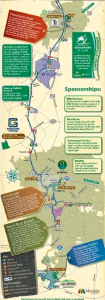An engineer's take on the history of railroads in Greenville, SC
 Swamp Rabbit Trail Maps: CLICK HERE[/caption]
Sam Tucker has railroading in his blood. He knows the history of railroads in Greenville, SC, when hobos took to the rails in boxcars, he remembers when cabooses were the second homes for engineers and he remembers when the Swamp Rabbit moved train cars between Travelers Rest and Greenville.
Today, the Swamp Rabbit Trail brings tens of thousands of strollers, bicycles and pedestrians down its paths where railroad ties used to be. While the timeline of the Swamp Rabbit Trail is well documented, the stories of those lines are still being told by those who remember a time when hobos could be seen riding the bumpers between freight cars, or on top of passenger trains – a method called Deck ’em because of the nature of the haul.
“They did away with the fireman, they did away with the brakemen, they did away with the flagman,” Tucker reflected with a hint of sentimentalism. “That orange thing on front of the train is the caboose. When we get ready to leave we put it on the rear car and it sends a signal.”
Swamp Rabbit Trail Maps: CLICK HERE[/caption]
Sam Tucker has railroading in his blood. He knows the history of railroads in Greenville, SC, when hobos took to the rails in boxcars, he remembers when cabooses were the second homes for engineers and he remembers when the Swamp Rabbit moved train cars between Travelers Rest and Greenville.
Today, the Swamp Rabbit Trail brings tens of thousands of strollers, bicycles and pedestrians down its paths where railroad ties used to be. While the timeline of the Swamp Rabbit Trail is well documented, the stories of those lines are still being told by those who remember a time when hobos could be seen riding the bumpers between freight cars, or on top of passenger trains – a method called Deck ’em because of the nature of the haul.
“They did away with the fireman, they did away with the brakemen, they did away with the flagman,” Tucker reflected with a hint of sentimentalism. “That orange thing on front of the train is the caboose. When we get ready to leave we put it on the rear car and it sends a signal.”
[gallery link="file" ids="2777,2781,2779,2782,2780,2783" orderby="rand"]
Mr. Tucker was finishing his shift and securing his diesel locomotive for the night when he stopped for a goodwill chat with passing locals on the Swamp Rabbit Trail. When pressed he admits the anything-goes glory days on the railroad are over because of the federal oversight on nearly all railroad lines in the United States. (Following the terrorist attacks on September 11th, 2001 and increased liability issues in recent years, regulators have installed cameras on trains and implemented strict procedures to help ensure safety and security on lines.) “There are a lot of stories I can’t tell, but let’s just say it was a different time for us before all the bureaucracy came,” Tucker said. The vagrants haven’t abandoned the lines altogether, says Tucker. In fact, the amount of energy he puts into keeping his trains safe and secure means he is as much a watchdog as he is a switch man. The hobos used to call policemen on the railroads the “Yard Dicks” and they made it their business to keep the vagrants off the trains. But he rarely finds anyone who can stand the hot boxcars in summer. But other security issues remain–larceny is the biggest problem. “They break locks and steal beer off the cars,” Tucker said. “We call it in when it happens and there’s a report. It’s all regulated now.”
Terminology reflected in the history of railroads in Greenville, SC
- Flipping a rattler – Boarding a moving box-car.
- Underslung – To get underslung means to ride under a train and have the shacks throw things at you, or to have them drag a piece of iron on a string under the car so that, bounding up and down, it will punish you plenty.
- Head end – The front of the train. In front of or near the engine.
- High ball – Signal for a train to pull out of town.
- Peddler or bob tail – A short local freight train.
